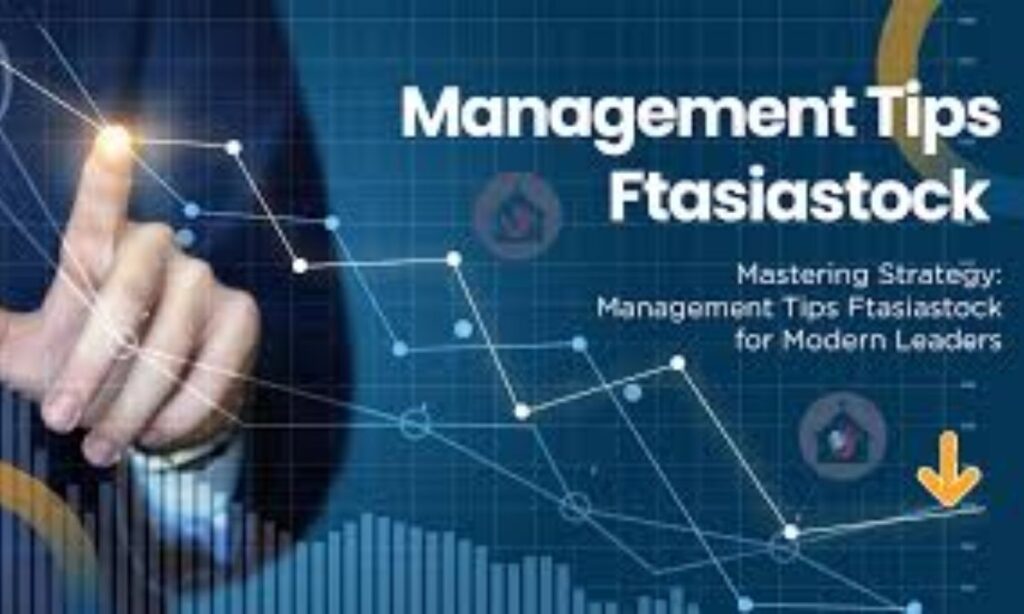Modern leadership demands more than traditional approaches. The business world moves fast. Leaders need fresh strategies. Management tips ftasiastock offers a revolutionary framework. It combines psychology with productivity. It balances structure with flexibility. This guide will transform how you lead.
Introduction to the Ftasiastock Management Philosophy
The ftasiastock philosophy changes everything. It’s not about rigid rules. It’s about adaptive thinking. This approach emerged from real-world business challenges. It studied what actually works. Traditional management often fails today. Teams need different guidance now. Remote work changed the game. Hybrid models require new thinking.
Ftasiastock focuses on three core elements. First, it values data-driven decisions. Second, it respects human psychology. Third, it promotes sustainable growth. These elements work together. They create lasting results. Leaders who adopt this philosophy see immediate changes. Their teams become more engaged. Productivity rises naturally. Burnout decreases significantly.
The philosophy rejects one-size-fits-all solutions. Every team is unique. Every leader has different strengths. Ftasiastock adapts to your situation. It provides tools, not templates. You choose what fits best. This flexibility makes it powerful. It works for startups and corporations alike.
What Sets It Apart?
Ftasiastock stands out for several reasons. It integrates behavioral science with business strategy. Most management systems ignore psychology. They treat workers like machines. Ftasiastock sees the whole person. It acknowledges different working styles. It respects natural rhythms.
Another unique feature is micro-adjustments. Big changes often fail. They disrupt workflows. They create resistance. Small tweaks work better. They’re easier to implement. Teams adapt quickly. Results compound over time.
Gamification plays a key role. Work doesn’t have to feel heavy. Ftasiastock makes progress visible. It celebrates small wins. Teams stay motivated. Competition becomes healthy. Collaboration improves naturally.
Decentralized decision-making is crucial. Top-down control slows everything. Junior team members have valuable insights. Ftasiastock empowers them. Decisions happen faster. Innovation increases. People feel ownership.
The Five Core Pillars of Management Tips Ftasiastock
1. Strategic Micro-Management Without Micromanaging
Micromanagement kills morale. Everyone knows this. But teams still need guidance. Strategic micro-management solves this problem. It provides oversight without suffocation. Leaders stay informed. Teams maintain autonomy.
The key is choosing the right touchpoints. Focus on outcomes, not activities. Check progress without hovering. Trust your team’s process. Intervene only when necessary. This builds confidence. It shows respect.
Implement the “3-Minute Sync”
Daily 3-minute syncs revolutionize communication. They’re too short to become meetings. They’re long enough to matter. Schedule them at consistent times. Keep them strictly time-bound. Focus on three things only.
First, identify roadblocks. What’s stopping progress? Address these immediately. Remove obstacles fast. This shows you care. It demonstrates support.
Second, celebrate momentum wins. Recognize progress made. Acknowledge effort invested. Positive reinforcement works. It boosts morale instantly. Teams feel valued.
Third, ensure KPI alignment. Are we on track? Do priorities match? Quick realignment prevents drift. It saves time later. Everyone stays focused.
These syncs replace lengthy status meetings. They save hours weekly. Information flows faster. Problems surface earlier. Solutions come quicker.
Tool: Use Voice Notes Instead of Emails
Email creates communication lag. Writing takes time. Reading takes energy. Voice notes solve both problems. They’re faster to create. They convey tone better. Nuance comes through clearly.
Implement voice notes for quick updates. Use platforms like Slack. WhatsApp Business works too. Keep messages under one minute. Be clear and direct. This respects everyone’s time.
Voice notes reduce misunderstandings. Tone prevents confusion. Urgency is obvious. Emotional context helps. Teams respond appropriately.
2. Elastic Goal-Setting Framework
Traditional goals are too rigid. Markets change constantly. Opportunities appear unexpectedly. Fixed deadlines create unnecessary stress. Elastic goals provide needed flexibility. They maintain accountability while allowing adaptation.
This framework recognizes complexity. Not all tasks are equal. Some require quick action. Others need deep thinking. Elastic goals honor these differences.
Replace Fixed Deadlines with “Progressive Windows”
Progressive windows change everything. They categorize work by urgency. Teams understand priorities better. Stress levels drop. Quality improves.
Tier A tasks get 2-3 days. These are urgent matters. They need immediate attention. Everyone knows their importance. Resources flow here first.
Tier B tasks receive 1-2 weeks. These are important but not critical. They allow for thoughtful work. Quality can be higher. Creativity has space.
Tier C tasks span one month or more. These are strategic initiatives. They require deep thinking. They can’t be rushed. Long timelines enable excellence.
This system reduces panic. Teams plan better. Work becomes more manageable. Deadlines feel reasonable.
Use “Cascade Goals” for Team Alignment
Cascade goals connect individual work to company vision. Everyone sees their impact. Personal goals align with team objectives. Team goals support company strategy. This creates powerful motivation.
Start with the big picture. Break it into department goals. Divide those into team targets. Finally, create individual objectives. Each person understands their role. Purpose becomes clear.
Review cascade alignment quarterly. Adjust as needed. Celebrate achievements together. This builds unity. Everyone feels part of something bigger.
3. Neuroproductivity Mapping
Brain science reveals important truths. People have natural productivity cycles. Energy levels fluctuate throughout the day. Fighting these rhythms wastes effort. Working with them multiplies results.
Neuroproductivity mapping optimizes schedules. It assigns tasks based on energy levels. Complex work happens during peak times. Simple tasks fill low-energy periods. This maximizes output.
Step 1: Assess Circadian Productivity
Everyone has different peak hours. Some people are morning larks. Others are night owls. Most fall somewhere between. Discovering these patterns is crucial.
Use productivity tracking tools. RescueTime provides detailed data. DeskTime offers similar insights. Track for two weeks minimum. Patterns will emerge clearly.
Look for consistent trends. When does focus peak? When do errors increase? When does creativity flow? These insights guide scheduling decisions.
Share findings with your team. Discuss patterns openly. Create flexibility around peak times. Protect deep work hours. This shows respect for individual differences.
Step 2: Implement “Neuro Zones” in Scheduling
Divide your calendar into three zones. Each serves different purposes. This structure protects productivity. It reduces context switching.
Focus Zones are sacred time. No meetings allowed. Deep work happens here. Complex problems get solved. Creative projects advance. Schedule these during peak energy hours.
Collab Zones enable teamwork. Brainstorming sessions fit here. Team syncs work well. Partnership discussions thrive. Energy can be slightly lower. Social interaction compensates.
Flex Zones handle administrative tasks. Email responses happen here. Simple updates fit perfectly. Routine work gets done. These align with lower energy periods.
Color-code your calendar. Make zones visually obvious. Protect boundaries consistently. Results will speak for themselves.
4. Inverse Leadership Technique
Traditional leadership flows downward. Leaders direct, teams execute. Inverse leadership flips this model. It creates accountability at all levels. It develops future leaders faster.
This approach feels uncomfortable initially. Leaders must show vulnerability. They acknowledge how they support others. This builds trust. It transforms culture.
Flip the Weekly Reports
Standard reports go upward. Employees report to managers. This reinforces hierarchy. It misses crucial elements. Inverse reporting changes dynamics.
Managers report downward instead. They explain how they enabled success. What obstacles did they remove? What resources did they provide? How did they support growth?
This accountability transforms leadership. Managers focus on serving teams. They become obstacle removers. They provide resources proactively. Teams feel genuinely supported.
Implement this gradually. Start with one team. Use simple formats. Focus on specific actions taken. Be honest about shortcomings. This builds credibility.
Install Decision Mirrors
Decision mirrors develop leadership skills. Junior team members practice senior decisions. They think through complex problems. They propose solutions. This builds capability.
Create regular workshops. Present real leadership challenges. Ask team members to decide. Discuss reasoning thoroughly. Explain actual decisions made. Compare approaches openly.
This accelerates development. People understand leadership complexity. Empathy for leaders grows. Future leaders emerge naturally. Succession planning becomes easier.
5. Invisible Systems: Automate Without Obviousness
Automation can overwhelm teams. Too many tools create confusion. Notifications become noise. Ftasiastock promotes invisible automation. Systems work behind the scenes. Teams barely notice them.
The goal is seamless operation. Data flows automatically. Updates happen without prompts. Everything just works. This reduces cognitive load. Teams focus on meaningful work.
Use Shadow CRMs
Traditional CRMs require manual updates. This wastes time. Information gets duplicated. Shadow CRMs solve this problem. They pull data automatically. They sync across platforms.
Motion auto-schedules intelligently. It optimizes task timing. It considers priorities automatically. Teams just work. The system handles logistics.
Zapier connects disparate tools. Data flows between platforms. No manual entry needed. Everything stays synchronized. This saves countless hours.
AI assistants track context. They monitor conversations. They flag action items. They remind appropriately. This happens invisibly. Work becomes effortless.
Case Studies Applying Management Tips Ftasiastock
Real results prove these concepts work. Three companies transformed their operations. Each faced different challenges. Ftasiastock principles solved their problems. The outcomes speak clearly.
Case Study 1: FinTech Startup in Singapore
This startup experienced hypergrowth. Revenue doubled quarterly. The team couldn’t keep pace. Burnout became epidemic. Turnover increased dramatically. Something had to change.
They implemented neuroproductivity mapping first. Peak hours were protected. Deep work time became sacred. Elastic goals replaced rigid deadlines. Tier systems reduced pressure.
Results came quickly. Project completion jumped 30 percent. Burnout reports dropped by half. This happened within two months. Team morale improved significantly. Quality actually increased.
Case Study 2: Creative Agency in Berlin
Decision-making bottlenecks plagued this agency. Everything required leadership approval. Projects moved slowly. Creativity suffered. Clients grew frustrated.
They adopted inverse leadership immediately. Managers started reporting downward. They focused on enabling others. Decision mirrors empowered junior staff. Three-minute syncs improved communication.
The transformation was dramatic. Fifteen hours weekly freed up. Decisions happened faster. Client satisfaction soared. The team felt trusted. Innovation accelerated naturally.
Case Study 3: SaaS Company in San Francisco
Tool fatigue overwhelmed this company. They had too many systems. Everything required multiple updates. Productivity actually decreased. Frustration ran high.
They switched to invisible systems. Shadow CRMs consolidated data. Redundant software was eliminated. Automation happened behind scenes. Simplicity returned.
The company saved $12,000 annually. More importantly, clarity improved. Teams understood workflows better. Cognitive load decreased. Focus returned to customer value.
Comparison Table: Traditional vs Ftasiastock Management
| Aspect | Traditional Management | Ftasiastock Approach |
| Goal Setting | Fixed deadlines, SMART goals | Progressive windows, elastic goals |
| Communication | Weekly status meetings | Daily 3-minute syncs, voice notes |
| Scheduling | Standard 9-5 structure | Neuro zones aligned with productivity peaks |
| Leadership Flow | Top-down reporting | Inverse leadership, decision mirrors |
| Automation | Visible tools requiring manual input | Invisible systems with automatic data flow |
How to Implement Management Tips Ftasiastock in Your Organization
Implementation requires thoughtful planning. Don’t change everything overnight. Start small and strategic. Build momentum gradually. Success breeds adoption.
Phase 1: Audit and Align
Begin with honest assessment. Examine current management systems. Identify what works well. Find disconnects clearly. Look for pain points.
Conduct productivity mapping sessions. Track team energy patterns. Note communication breakdowns. Survey team satisfaction. Gather honest feedback.
Analyze decision-making speed. Where do bottlenecks exist? Who has authority? What requires approval? This reveals structural issues.
Phase 2: Execute Selectively
Choose two or three tactics initially. Don’t overwhelm your team. Start with highest-impact changes. Test with one department first.
Implement 3-minute syncs perhaps. Try neuro-zoning schedules. Introduce progressive windows. Measure everything carefully. Track specific KPIs.
Monitor response time improvements. Assess task throughput changes. Survey team sentiment regularly. Adjust based on feedback. Refine your approach.
Phase 3: Scale and Automate
Gradually expand successful tactics. Introduce invisible systems carefully. Implement cascade goal alignment. Roll out inverse reviews quarterly.
Train managers on new approaches. Provide ongoing support. Celebrate early wins publicly. Share success stories. Build organizational momentum.
Create feedback loops. Continuously improve systems. Stay flexible always. Adapt to changing needs. This ensures lasting success.
The Future of Leadership is Adaptive
The business world keeps changing. Hybrid teams are now standard. AI integration accelerates daily. Global workforces span timezones. Old management styles can’t cope.
Frasi stock principles address tomorrow’s challenges. They embrace flexibility naturally. They respect individual differences. They leverage technology wisely. They develop human potential fully.
Adaptive leadership isn’t optional anymore. It’s survival. Companies that evolve will thrive. Those that don’t will struggle. The choice is clear.
Frequently Asked Questions
What makes ftasiastock different from traditional management?
Ftasiastock emphasizes adaptive strategies over rigid rules, integrates psychology with productivity, and uses micro-adjustments rather than massive overhauls for sustainable change.
How long does it take to see results?
Most organizations notice improvements within 2-3 weeks of implementing initial tactics, with significant transformation typically occurring within 2-3 months.
Can ftasiastock work for small teams?
Absolutely. The principles scale perfectly for teams of any size, from five people to five hundred, making it ideal for startups and small businesses.
Do I need special software to implement this?
No. While tools like RescueTime or Zapier help, the core principles work with basic communication platforms and simple tracking methods you likely already use.
What if my team resists these changes?
Start with voluntary pilot groups, demonstrate quick wins, involve team members in planning, and emphasize how changes reduce their workload rather than increase it.
Conclusion
Mastering modern leadership requires fresh thinking. Ftasiastock management tips provide that framework. They combine timeless wisdom with innovative approaches. The five core pillars work together seamlessly. Strategic micro-management maintains connection without control. Elastic goals provide flexibility with accountability. Neuroproductivity mapping maximizes natural energy. Inverse leadership builds trust and capability. Invisible systems reduce friction automatically.
The case studies prove these concepts work. Real companies achieved remarkable results. They increased productivity significantly. They reduced burnout dramatically. They saved time and money. Most importantly, they built stronger cultures.






